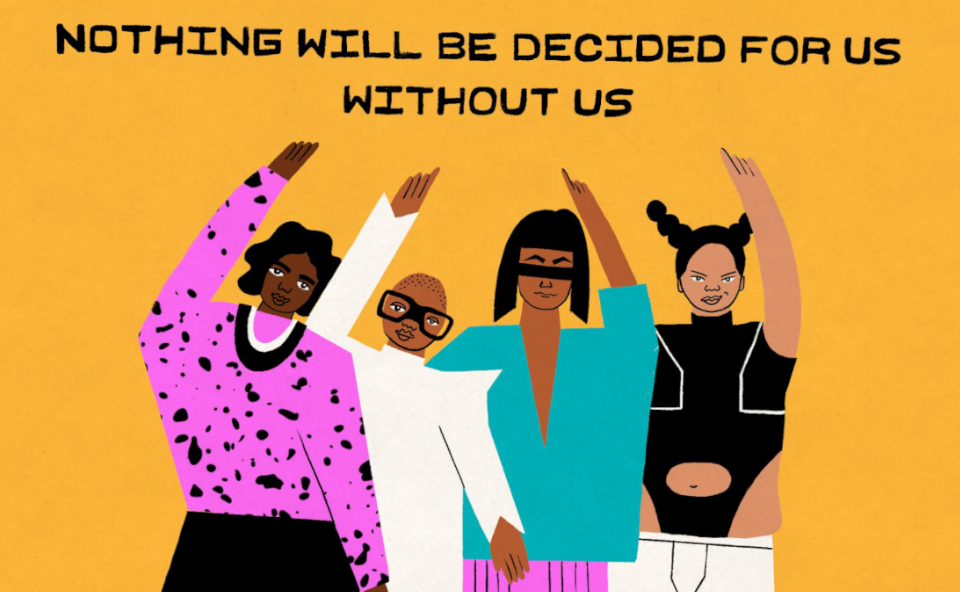
Image description: Illustration showing four different women with fists up. Image source: FRIDA’s Principles to Guide Data & Technology
It is no secret for feminist activists that the internet is not a safe space for organising. With the COVID-19 pandemic, and under the different forms of lockdowns, there was a stark increase in violence against women and LGBT+ people. Feminist activists have turned to online tools to keep connected, organise and fight back whilst providing key support and accompaniment to victims of gender-based violence. Beyond organising, we have seen an increase in the use of online tools, particularly Zoom, WhatsApp and social media apps, for people to feel connected, spend time together, for leisure and more. Internet servers everywhere were overcrowded with users and our social media timelines were full of Instagram live events, Zoom calls and apps to party.
Nevertheless, it wasn’t long before corporatised telecommunications failed their users, again. Zoom and Jitsi rooms were invaded by men on the internet who crashed their meetings with sexually explicit content, racist and sexist language and more, known as “Zoombombing”, and the company is yet to ensure user’s safety. Likewise, platforms like Facebook and Twitter continue to fail marginalised groups by pulling down their posts, enabling their content to be seen by far-right extremists, and spreading misinformation and fake news without proper checks and balances. Recently, The Atlantic published a report of how Facebook ads enable the Trump campaign and his far-right messaging. Meanwhile, recently Twitter has come under fire for double standards in removing certain posts from the Black Lives Matter movement but failed to take action against racists and far-right extremists on their platforms. Corporate-owned telecommunications keep exposing their fault lines, and without proper alternatives, we continue to use them en masse, handing over our data for their profit.
Zoom and Jitsi rooms were invaded by men on the internet who crashed their meetings with sexually explicit content, racist and sexist language and more, known as “Zoombombing”, and the company is yet to ensure user’s safety.
It can feel like this reality of internet surveillance and control over our lives is impossible to escape but there are solutions and feminists have them. There is a huge amount of alternative tech tools but most of them are built, and maintained by, feminist activists who often do this on a voluntary basis maintaining other jobs and virtually no money or the lucky few who are able to get a job in an international organization but still build the feminist internet on the side. Feminists have been building their own servers, pads, period tracking apps, websites and more to be able to organize safely with little to no support from international human rights philanthropy or social investment. Meanwhile, alternative, open source and encrypted tools developed by white, cis-gendered, men in the Global North, like Riseup.org, TOR or Signal are incredibly well funded.
The feminist internet is chronically underfunded:
I attended the Internet Freedom Festival in 2019 where I went to a talk by a group of feminist organizers about a new, safe period tracking app called Drip. Built by feminists in Berlin for those who experience periods, the app was still in its beta version in spite of being built in 2016. In fact, it is currently still in construction and only available on Google Play. On the other hand, there are multiple examples of cyberfeminist initiatives that went under due to complete lack of funding, like the Mexican cyberfeminist collective Kefir, one of the first feminist collectives to develop pads, websites and other products for the feminist movement but recently closed their doors. I spoke with N. the founder of this collective to understand better how she sees funding in the feminist internet space. N. spoke to me about the toxic dynamics, burnout and overwork that lack of funding creates within the feminist internet space. It is often the case within the cyberfeminist community that some of these activists may be employed within international human rights organizations and others have multiple forms of income, while also building and maintaining these machines and tools so vital for feminist organizers. This precariousness and scarcity lead to competition and other rivalries that may develop into dynamics that can harm the movement as a whole and lead to activists leaving this space altogether.
The feminist internet movement needs funding but make no mistake - we (funders, users and consumers) need it more than it needs us. This community is based on the principles of intersectionality, meaning that the fight for internet freedom cuts across the multiple other challenges we face as women and gender non-conforming people of different racial and ethnic backgrounds. The feminist internet will be anti-racist and trans-inclusive! In this sense, the trans feminist internet discourse and the technologies stemming from that are carrying out groundbreaking work. A good example of this is the transfeminist algorithm manifesto, penned by Lili Anaz and Ana Akhmatova. In this piece, the concept of the algorithm is examined, deconstructed and re-imagined from a transfeminist perspective. In this new internet (re-)imagined and built from the perspective of those who have been marginalised, we all fit, we all have a space. In other words, the tools are made to fit the needs as queer feminists in the Global South while it is keeping us all are safe. In the traditional definition of what the internet is, from the perspective of white, cis-gendered, Global North men, are these issues even relevant? Probably not. In the traditional definition of what feminism or the women’s movement is, are algorithms, software and servers part of the gender justice discourse? Hardly. Still, making the connection between internet freedom and gender justice is central to how we think about a world after the pandemic.
In this new internet (re-)imagined and built from the perspective of those who have been marginalised, we all fit, we all have a space.
The truth is that an intersectional and participatory framework to funding is needed to resource the feminist internet in a way that serves the needs of this community withou comprising their principles. The tech we use is patriarchal, white supremacist and capitalist but as donors, users and consumers, we regularly take for granted our massive use of Google, Facebook, Twitter, Dropbox and other platforms for comms, data collection and storage that commercialize not only our organizations’ information but the information of the movements we serve. While governments are spending millions of dollars on surveillance technology to collect information about social justice leaders, feminist organizers, youth groups and more, funders are tacitly handing over this information and helping corporations make a profit in the process.
Furthermore, social movement funders could help tip the balance to favour freedom of expression and digital rights if there is a larger pool of funds for the feminist internet. The crisis of funding in the internet freedom movement has been a central topic of debate of late. The Open Technology Fund was taken over by Trump supporters and virtually defunded, while Mozilla laid off 25% of its staff due to the economic recession caused by lockdowns. Even the larger funders of internet freedom are coming under attack as a tragic proof that attacking and controlling digital interconnection across the world is a key way to establishing the power of right-wing fundamentalism currently on the rise. The ability to hamper, control and surveil our digital communications as feminists and social justice activists gives corporations and governments the ability to reinforce their discourse and surveil our strategies for social change.
On the other hand, tech funders are often pushed constantly on funding feminist internet initiatives but shy away from the debate of what it means to fund this work. The progressive tech movement mirrors the tech sector writ large and the efforts for the inclusion of women, trans folks from the Global South in the internet freedom movement is long and exhausting. Although cyberfeminists have done a lot to put forward their priorities as a movement to funders, it can be argued that internet freedom funders remain unconvinced of the centrality of gender issues and only see it as an add-on or a subset of the sector.
But that isn’t the only explanation. I’ve spoken to a few feminist infrastructure advocates about the funding challenges they face who explained to me that often funders have impossible reporting standards that require a lot of time or they have to fit a really complex and nuanced tech project into white and patriarchal definitions of technology. On the other hand, cyberfeminist activists are well aware of the politics behind money and are not always so keen on being funded by donors where their work runs the risk of being co-opted or used by the wrong hands. Rooted in anarchist and anti-capitalist thinking, cyberfeminists would rather guard their work from commercial tech corporations seeking to make a profit of technology or give this essential information to governments for surveillance and control, than to have access to a large pool of resources.
Right-wing fundamentalism knows full well that the takeover of the internet and the digital commons is key to securing power. Human rights philanthropy can tilt the scales by funding the alternative, open and free technology that social movements need to organize and where we can safely and securely connect to each other. However, the conversation is not one-sided. Philanthropy needs to adopt more flexible and core grantmaking strategies that centre communities building this infrastructure on the basis of values which protect values of privacy, human dignity and safety, the values that underpin feminist activism and philanthropy.
Right-wing fundamentalism knows full well that the takeover of the internet and the digital commons is key to securing power.
The pandemic showed us how we are dependent on an internet infrastructure to be able to organize and remain connected even when we can’t do so in person. However, the internet remains a battleground where corporations and governments are developing state of the art technology aimed at the surveillance of groups and activists to stop us from gaining any ground. On the other side, we see cyberfeminist activists working in internet freedom resisting this by building servers, developing apps, websites, software that can serve as a backbone of feminist activism and can guarantee queer folks, women and trans youth can use the internet safely, but who are severely underfunded in an ever-increasing global economic crisis. Funding cyberfeminist initiatives can be a gamechanger for the takeover of right-wing fundamentalism over the media and internet, however funders need to recognise the specific needs of these communities and be willing to be flexible to get to the communities building essential infrastructure today.
The internet, like the streets, needs to be reclaimed. We can build new spaces of engagement, organizing and transformation but in order to achieve this, we need funding that can ensure those building the feminist internet that they can make decisions over where their knowledge goes. Let’s begin with a common strategy to work together to.
The internet, like the streets, needs to be reclaimed.
- 7647 views







Add new comment